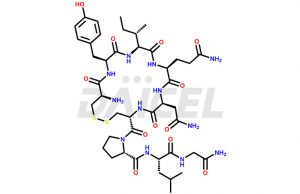LOAD MORE
You're viewed 9 of 11 products
Daicel Pharma synthesizes high-quality Oxytocin impurities, [Ala (3-CN) 5] Oxytocin, Ac Oxytocin, Anti parallel dimer Oxytocin, Asp 5-Oxytocin, D-Asn 5-Oxytocin, Glu 4-Oxytocin, Leu 3-Oxytocin, Oxytocic acid, and Parallel dimer Oxytocin that help in the quality, stability, and biological safety analysis of Oxytocin. We also offer custom synthesis of Oxytocin impurities and supply worldwide.
Oxytocin [CAS: 50-56-6] is the main uterine-contracting, milk-ejecting pituitary gland hormone1, which is composed of nine amino acids. It plays a crucial role in various physiological processes, including stimulating parturition and lactation. However, it also influences other vital physiological processes such as metabolic and cardiovascular functions, maternal and sexual behavior, and social cognition.
Oxytocin is administered during the antepartum period to either initiate or improve uterine contractions, particularly in situations where fetal or maternal well-being is a concern. Additionally, Oxytocin may be used to augment labor in certain cases of uterine inertia and as a supplementary therapy in managing incomplete or inevitable abortion. In the postpartum period, Oxytocin may help stimulate contractions during the third stage of labor and manage postpartum bleeding or hemorrhage. Further, oxytocin is under clinical study for autism spectrum disorder and osteoarthritis.
Oxytocin is administered either by intravenous injection or intramuscular injection. It is available under various brand names, including Pitocin and Syntocinon. It is one of the thirteen priority life-saving medicines listed by the UN Commission on Life-saving Commodities for Women and Children2. 
The chemical formula of Oxytocin is C43H66N12O12S2, and its molecular weight is 1007.19 g/mol.
Synthetic Oxytocin causes the same pharmacological response as naturally occurring Oxytocin. The amount of Oxytocin needed for labor stimulation can be predicted based on cervical dilation, parity, and gestational age. Oxytocin works by increasing the sodium permeability of uterine myofibrils and leads to the indirect stimulation of the uterine smooth muscle. The uterus is more responsive to Oxytocin when estrogen levels are high and the long pregnancy duration.
Impurities can arise during the synthesis or purification process of Oxytocin. These impurities include incomplete peptide chains, modified peptides, and residual solvents or reagents, which can be a concern for patient safety, particularly in the case of toxic or immunogenic impurities.
At Daicel, we provide a Certificate of Analysis (CoA) from a cGMP-compliant analytical facility for Oxytocin impurity standards, [Ala (3-CN) 5] Oxytocin, Ac Oxytocin, Anti parallel dimer Oxytocin, Asp 5-Oxytocin, D-Asn 5-Oxytocin, Glu 4-Oxytocin, Leu 3-Oxytocin, Oxytocic acid, and Parallel dimer Oxytocin, along with complete characterization data including 1H NMR, 13C NMR, IR, MASS, and HPLC3. Upon request, we provide 13C-DEPT and CHN. Also, we provide a complete characterization report upon delivery. Daicel offers highly pure isotope-labeled standards of Oxytocin in bioanalytical research and BA/BE studies with isotope data in CoA.
The most common impurities may include Asp-5-oxytocin, des amino-Oxytocin, and oxidized Oxytocin. The specific impurities present may vary depending on the manufacturing process and other factors.
Methods used to identify Oxytocin impurities include high-performance liquid chromatography (HPLC), and liquid chromatography mass spectrometry (LC-MS).
Oxytocin impurities may impact clinical trials and drug approval by affecting the safety and efficacy of the product. Further, the regulatory authorities may need additional testing or data to demonstrate the safety and quality of the product.
Oxytocin impurities are removed from the medication using purification techniques, such as reverse-phase high-performance liquid chromatography. However, it is ideal to minimize the formation of impurities during the manufacturing process.
Note: Products protected by valid patents by a manufacturer are not offered for sale in countries having patent protection. The sale of such products constitutes a patent infringement, and its liability is at the buyer's risk.